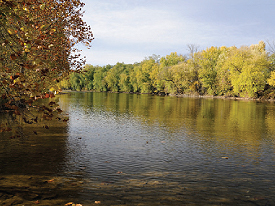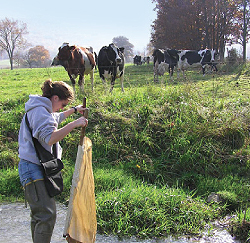Central Valleys and Ridges’ Watersheds Impact Health of Chesapeake Bay

The Juniata River flows through Pennsylvania’s Central Valleys and Ridges and joins the Susquehanna, which is a Chesapeake Bay tributary.
A typical field day for a watershed manager in Pennsylvania’s Central Valleys and Ridges region involves work on modified mud sill cribs, roof runoff management and riparian zones. Jennifer Farabaugh and her colleagues in the Western Pennsylvania Conservancy’s Watershed Conservation Program participate in a wide range of efforts, such as watershed conservation plans, bathymetry initiatives and macroinvertebrate studies. One day, she may be educating a farmer outside of Huntingdon, Pa., about best management practices that protect water quality. The next day, she may be beside Sideling Hill Creek, collecting samples to test.
This all sounds complicated, but Farabaugh and her colleagues’ goals are simple: improve the water quality in the region in an effort to, in part, impact the health of the Chesapeake Bay.
The Chesapeake Bay is the largest estuary in the United States and its watershed touches parts of six states (Delaware, Maryland, New York, Pennsylvania, Virginia and West Virginia) and the District of Columbia. The Central Valleys and Ridges region, which is a large swatch of southcentral Pennsylvania, sits in the western to northwestern portion of the watershed. The region is home to the Potomac River tributaries and the Juniata River basin, so the area provides a significant amount of the water that flows into the Chesapeake Bay.
“This is an important location because it’s part of the headwaters,” said Farabaugh, WPC’s Juniata and Potomac watershed manager who works in the Conservancy’s Hollidaysburg, Pa., office. “If you start out with impaired water in the headwaters, it impacts the entire watershed.”

Jennifer Farabaugh, WPC’s Juniata and Potomac watershed manager, conducts research in front of streambank fencing, which not only improves the water quality of the stream but also helps keep the livestock healthy.
Over the years, WPC has improved water quality in Sideling Hill Creek, Yellow Creek, Spruce Creek, Cove Creek and other watersheds by partnering with conservation groups and by helping farmers and landowners implement conservation practices that reduce stream pollution.
About two years ago, the U.S. Environmental Protection Agency (EPA) established the Chesapeake Bay Total Maximum Daily Load (TMDL), a “pollution diet” with rigorous accountability measures for the states that reside within the watershed.
It’s not uncommon for farms or portions of farms to be located in riparian zones, or land adjacent to streams that impacts water quality and fish habitat and serves as migration corridors. In the case of farms in the Central Valleys and Ridges region, the riparian zones are within the watershed.
Therefore, the Conservancy, through the Watershed Conservation Program, is helping farmers and the state reach nutrient reduction requirements within the Chesapeake Bay watershed. New regulations mandated by the state require all farmers to develop and implement an erosion and sediment control plan for their operations.
WPC’s watershed conservation program also helps farmers comply with the new manure management requirement. Over the past five years, the organization has completed nearly 20 plans for farmers in the Chesapeake Bay watershed.
In addition to developing nutrient manure management plans, the program offers on-site consultation for the implementation of related best management practices, such as stabilized stream crossings, roof runoff management, waste storage and general barnyard management.
So far, WPC has helped nearly 50 agricultural operators install 26.5 miles of streambank fencing, more than 15 alternative watering systems and nearly 80 stabilized stream crossings in the Chesapeake Bay watershed.
Moreover staff members help farmers identify and apply for grants that can help them pay for the practices.
WPC doesn’t just work with farmers — it helps other private landowners to reduce nutrient and sediment runoff. One such program is taking place in the Morrison Cove region, which is in Bedford and Blair counties. The Conservancy is partnering with landowners to repair malfunctioning on-lot septic systems.
Additionally, WPC works with private landowners to reduce stream bank erosion and sedimentation by stabilizing more than 3,000 feet of eroding stream bank in the region. Using stream bank stabilization techniques such modified mud sill cribbing also improves habitat for trout because the undercut bank works as a cover for the fish.
